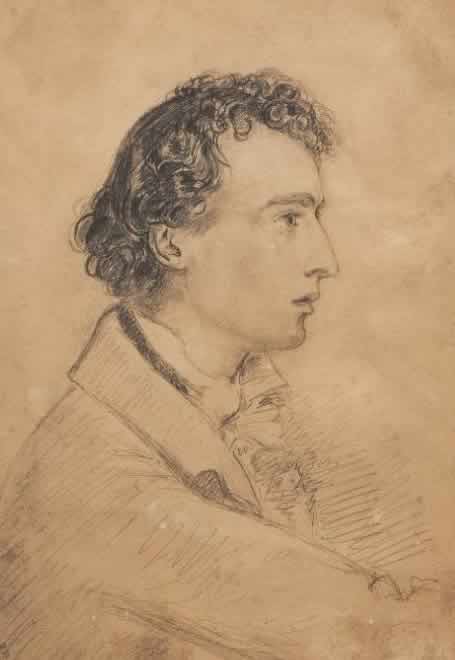15 November 1820: Rome: Oh, God! God! God!
—An Awkward Bow to Life Having Past
Piazza di Spagna, Rome (1800 map)


Keats arrives in Rome at 15 November, having taken a carriage from Naples a week earlier.
He
initially lands by sea at Naples, 21 October, only to be quarantined on his ship for
ten days.
Keats is accompanied by his friend, the young painter Joseph
Severn, who voyages with Keats from London, beginning 17 September. In Rome, Keats and
Severn stay at a second-floor apartment at 26 Piazza di Spagna (which is now Keats-Shelley
House, a museum dedicated mainly to Keats, Percy
Shelley, and their circles). Severn, feeling helpless but trying his best to help
Keats, records that Keats arrives in Naples with a shattered frame—and broken heart
(letters, 1, 2 Nov).
Keats’s state is indeed horrible, though Keats attempts to muster both personal fortitude
and
philosophical distancing: to Brown he writes, I will endeavor to bear my miseries patiently
[. . .] It surprised me that the human heart is capable of containing and bearing
so much
misery
(letters, 1 Nov). This is as much a personal statement as a confirmation of what
Keats, very deliberately, attempts to address in his best poetry. Even at this desperate
moment, the statement clearly, but naturally, draws upon Keats’s complex engagement
with the
poetic depths of William Wordsworth’s
greatest poetry, which is centered in the human heart
and bears what Wordsworth calls
the burden of the mystery
(from Wordsworth’s poem that Keats knows so well,
Tintern Abbey,
with the phrase human heart
being pulled from another poem by
Wordsworth that Keats knows equally well, The Intimations [Immortality] Ode
).
Keats travels to Italy with the vague hope of reversing his rapidly failing health. Despite the haphazard medical diagnosis that he might have some digestive issues (and earlier diagnosis that he suffers from extreme anxiety only), to be remedied by fresh air and exercise (including horseback riding!), Keats clearly suffers from consumption—pulmonary tuberculosis—that has recently spread from his lungs to his stomach. Keats has had a fever for months, indicating gross, systemic infection. Given Keats’s own medical training, his long-standing issues with coughing/chronic throat difficulties, witnessing the deaths of younger brother and mother from consumption, and blood-spitting that began about nine months earlier, Keats is himself too aware of his condition.


From Naples on 1 November, Keats writes to Charles
Brown, who is his best friend, former roommate, travelling companion, financial
supporter, and the person with whom he intended to travel to Italy. Misery, regret,
despair,
and utter helplessness intermix with great passion and longing. Keats confides his
regrets to
Brown, that his relationship with Fanny Brawne,
to whom he was betrothed, was never consummated: My dear Brown,
Keats writes, I
should have had her when I was in health, and I should have remained well. I can bear
to
die—I cannot bear to leave her. Oh, God! God! God!
Keats says that he vividly imagines
Fanny, but in doing so, he can only describe it in metaphors of acute pain—of being
pierced
and scalded, with feelings of coals of fire in my breast.
On 8 November, from Louisville, Kentucky, Keats’s brother George writes that his thoughts are with Keats: Your inevitable
distresses are subject to conversation to us [him and his wife, Georgiana] almost every day . . .
. In the meantime, George
tells Keats about his efforts to keep his business venture going—George Keats & Company.
But George’s goal to make money in America and then return to England is never achieved;
part
of his hope was to help out Keats. George will himself die of consumption in 1841,
though he
will eventually have some business success in Kentucky. His decision to remain in
the US is
likely based to some degree on the cruel fact that he’s lost both of his brothers.

Subtly, yet strikingly, Keats gives us a glimpse back into his mature poetics. It
is, in a
way, Keats’s final word about poetry. It briefly returns us to the moment when, about
two
years earlier, he crucially describes his own poetical Character
—which anticipates what
he achieves in the remarkable poetry to come in 1819. It is that famous (famous at
least for
us) moment when he describes writing not with the qualities of the wordsworthian or
egotistical sublime
but as a camelion Poet,
one who lives in contrasts, be it
foul or fair, high or low, rich or poor, mean or elevated.
It enjoys, he writes,
light and shade
(letters, 27 Oct 1818). Now, two years later, on 30 November to Brown, and with thoughts of Fanny Brawne haunting and taunting him, and with a future
frightfully darkened by an imminent and agonizing death, he recognizes that in his
condition
and situation there is material necessary for a poem
: the knowledge of contrast,
feeling for light and shade.
But it is a poem he cannot write. What he profoundly calls
his posthumous existence
prevents him, and so, camelion-like, he can only disappear
into anxious thoughts about the life he hoped he might have lived and into the uncertainty
of
what the future, might, if anything, give him.
This is the last letter from Keats we know of; he signs off with sad thoughts about
his sister and
brothers; and he adds, as a revealing but
consistent gesture of his own character, I can scarcely bid you good bye even in a letter.
I always made an awkward bow. / God bless you! / John Keats.
Keats’s own poetry of April 1819 can be brought to bear upon his struggle: How fever’d is
the man who cannot look / Upon his mortal days with temperate blood . . .
(On Fame [How fever’d
is the man]). Keats, though extremely fevered, does, at this moment of
farewell, summon a dignified and poetic expression of his own character and upon his
diminishing mortal days.


